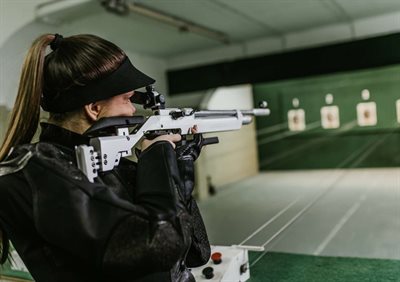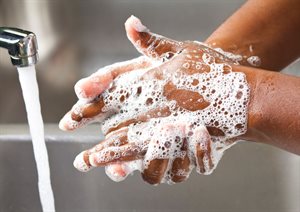Lead Exposure – Indoor Rifle Ranges
Lead is a naturally occurring toxic metal found in the earth’s crust that has many uses, including in the manufacture of ammunition
The processing, handling, use and disposal of lead can result in widespread environmental contamination and lead to human exposures.
to human exposures.
Lead Exposure
Exposure to lead over a short, or prolonged, period can cause lead poisoning and health problems.
Lead exposure can occur from handling lead ammunition (dermal absorption) or from dust (ingestion or inhalation) produced by firing a gun and when a lead pellet impacts a target, target stand or other objects.
Lead will also be present in any dust filtered by any extraction system. Where possible, use jacketed or lead‑free bullets and non‑lead primer to eliminate the risk.
Duties of Range Operators
The Health and Safety at Work etc. Act 1974 requires every employer to take reasonable steps to ensure the health, safety, and welfare at work of all employees, and to operate their undertaking in a way that does not put the health and safety of customers, visitors and contractors at risk.
All employers and self-employed persons must also carry out a suitable and sufficient assessment of the risks to employee and non-employee health and safety associated with the activities under his control and take reasonable steps to either prevent or effectively mitigate all significant risks.
Where employees are liable to experience significant exposure to lead, air monitoring must be undertaken at least every 3 months to measure the concentration of lead in the air, and health surveillance arrangements must be put in place.
Local Exhaust Ventilation System (LEV)
All control measures used to mitigate exposure to lead must be maintained in an efficient state, in an efficient working order, in a good state of repair, and in a clean condition. To ensure LEV systems continue to operate correctly, they must be checked in accordance with the manufacturer instructions and be capable of dealing with dust and unburnt propellant safely.
The Control of Lead at Work Regulations 2002 states that LEV systems must be thoroughly examined and tested at least every 14 months with a suitable record of examinations and tests, and necessary repairs, being retained for at least 5 years from the date on which they were made.
Rifle Range Cleaning
The frequency of cleaning will be influenced by the risk assessment and factors such as: A. The type of ammunition fired e.g. centrefire pistols firing unjacketed ammunition will require more frequent cleaning than rimfire rifles; pistols eject a considerable amount of unburnt propellant; and unjacketed ammunition create more lead dust than jacketed ammunition.B. The frequency the range is used, and number of rounds fired. C. The efficiency of existing ventilation and extraction. D. The porosity of surfaces down range. All cleaning and de-leading (if applicable) should be recorded in the Range Log together with the name, or job status, of the person responsible for the overall supervision.
Cleaning Methods
To effectively control the risk of lead exposure, anyone responsible for cleaning surfaces in an indoor firing range must use wet methods for cleaning and/or a HEPA filtered vacuum cleaner. Dry sweeping and dusting is strictly forbidden. Cleaning the firing range area should only be undertaken by staff with adequate Personal Protective Equipment (PPE) and who have received sufficient training on the hazards of lead exposure and the correct use of PPE provided. Disposable overalls, gloves and masks should be worn at all times during cleaning activities and indoor repair and maintenance work.
Deep Cleaning
Periodic deep cleaning should be undertaken by specialist contractors since it involves removing all residual dust from the structure including roof spaces, tubes, target and bullet trap areas (including any anti backsplash curtains). It is sensible to de-lead and maintain bullet traps just before a deep clean as this process can generate considerable dust. The frequency of deep cleans will be dependent upon range use.
Health & Hygiene – Hand Washing Facilities
Adequate hand washing facilities with hot and cold (or mixed) running water, liquid soap and hygienic hand drying facilities should be readily available to all persons using the indoor firing range to facilitate regular hand washing after the handling and loading of ammunition. The importance of regular hand hygiene should be effectively communicated to all range users through clear signage.
facilities should be readily available to all persons using the indoor firing range to facilitate regular hand washing after the handling and loading of ammunition. The importance of regular hand hygiene should be effectively communicated to all range users through clear signage.
Health & Hygiene – Consuming of Food & Drink
Eating, gum chewing, drinking, and smoking are forbidden in an indoor area used as a firing range. The Range Operator is responsible for communicating the importance of thorough hand washing after leaving the indoor range before anyone eats, drinks or smokes. Additional signage can be used to remind users to that food and drink is not permitted in the firing range area.
Useful information links
Please visit the National Rifle Association website, where a copy of their Range Design & Safety Handbook and other useful information can be found by visiting
Legislation, Relevant Guidance & Approved Codes of Practice
Health and Safety at Work etc. Act 1974 (legislation.gov.uk)
The Management of Health and Safety at Work Regulations 1999 (legislation.gov.uk)
The Control of Lead at Work Regulations 2002 (legislation.gov.uk)
https://www.hse.gov.uk/pubns/books/l132.htm
The Personal Protective Equipment at Work Regulations 1992 (legislation.gov.uk)
The Control of Substances Hazardous to Health Regulations 2002 (legislation.gov.uk)
The Dangerous Substances and Explosive Atmospheres Regulations 2002 (legislation.gov.uk)
Acknowledgements
The information on this page has been compiled from information provided by the National Rifle Association.